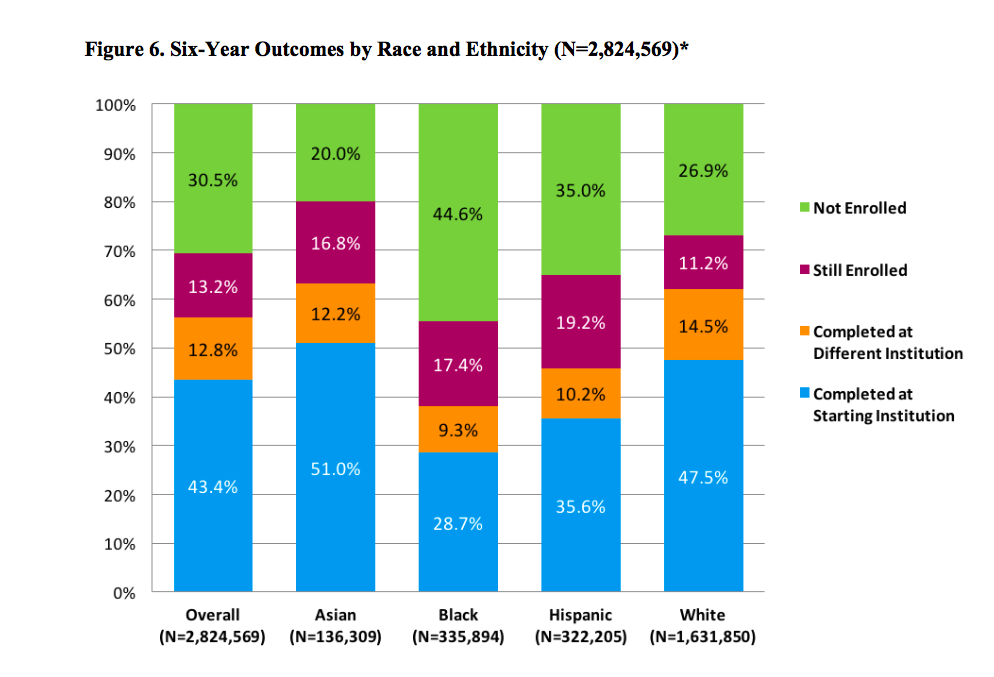On average, white and Asian students earn a college-level credential at a rate about 20 percentage points higher than Hispanic and black students do, a new report shows.
April 26, 2017,Inside Higher education
College completion rates vary widely along racial and ethnic lines, with black and Hispanic students earning credentials at a much lower rate than white and Asian students do, according to a report released Wednesday by the National Student Clearinghouse Research Center.College completion rates fluctuate widely by race and ethnicity, a new report finds.
The center evaluated data from students nationwide who entered a college or university in fall 2010. The data represents students at two- and four-year colleges, students who studied part- and full-time, as well as those who graduated after transferring institutions.
Altogether, 54.8 percent of those students completed a degree or certificate within six years of entering a postsecondary institution, but broken down by race and ethnicity, those rates fluctuate by up to 25 percent.
White and Asian students completed their programs at similar rates -- 62 percent and 63.2 percent, respectively -- while Hispanic and black students graduated at rates of 45.8 percent and 38 percent, respectively.

These numbers likely won’t surprise most people who track higher education closely, as they fall in line with what other studies have found over the years, but “it will certainly reinforce the point that there’s more work to be done,” said Doug Shapiro, one of the lead authors of the report.
This report is valuable, he said, because it uses the most recent available data and accounts for part-time students and students who transfer to another institution during their studies. Other studies had not previously done this -- though that is because most have focused on federal databases, which have historically tracked only full-time, first-time students. The clearinghouse has become an alternative source of information on student outcomes and mobility because of its distinctive set of data.
“To the extent that the findings were surprising, it was simply that what we found did not change what we knew,” said Shapiro, who is executive research director at the National Student Clearinghouse. “For example, black and Hispanic students were no more likely to transfer and graduate somewhere else, and in fact, in most cases, they were less likely.”
The report also found that, nationally, students who entered a four-year public university earned a degree or certificate at a rate of 62.4 percent. Students who started at a two-year public institution had an overall completion rate of a credential of 39.2 percent. At four-year institutions, black men completed their degrees at the lowest rate (40 percent) and Asian women at the highest (75.7 percent).
Students who started at community college and then continued their educations at a four-year public institution experienced very different outcomes, depending on race and ethnicity. After six years, about a quarter of Asian students and a fifth of white students had finished their degrees, compared to about a tenth of Hispanic students and one in 12 black students.
“Community colleges have long been held out as engines of access to higher education,” Shapiro said, making these “disappointing results -- the rate at which students from underrepresented groups managed to complete that transfer from community college to a bachelor degree.”
For years, colleges and universities had been asking for racial and ethnic breakdowns of completion rates. After releasing those results for the first time this year, the National Student Clearinghouse plans to release updated data annually, Shapiro said. Each institution will also be able to see its own data and compare to national trends.
“We think that will be really powerful,” Shapiro said. “It will help [institutions] understand where they need to focus their improvements.”


Nenhum comentário:
Postar um comentário